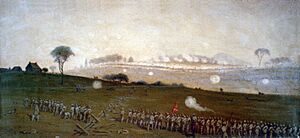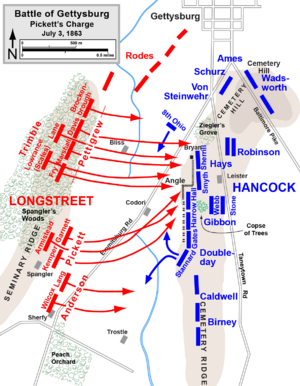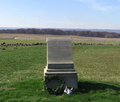Pickett's Charge facts for kids
Pickett's Charge was a huge infantry (foot soldier) attack. It was ordered by Confederate General Robert E. Lee. The attack was aimed at the Union positions. These positions were held by Major General George G. Meade's army.
The charge happened on Cemetery Ridge on July 3, 1863. This was the last day of the Battle of Gettysburg. The Battle of Gettysburg was a major event in the American Civil War. Lieutenant General James Longstreet was in charge of the attack. He actually believed it would fail. The farthest point the Confederates reached is called the "high-water mark of the Confederacy."
Contents
What Was Pickett's Charge?
This famous attack is named after Major General George Pickett. He was one of three Confederate generals. They led the charge under Lieutenant General James Longstreet. Longstreet himself thought the attack would not work. The farthest point reached by the Confederates is known as the "high-water mark of the Confederacy."
Why Did the Attack Happen?
General Lee hoped to attack the Union center. This was on the third day of the Battle of Gettysburg. Confederate attacks on both sides of the Union lines had failed. These earlier attacks happened the day and night before. On the night of July 2, General Meade held a council of war. He thought Lee would try to attack his lines in the center the next day.
The Attack Itself
A large artillery (cannon) attack happened first. This was before the infantry charge. The Confederates hoped the cannons would make the Union soldiers weaker. But this artillery attack did not work well.
About 12,500 Confederate men took part in the charge. They were organized into nine infantry brigades. These soldiers marched across open fields. They walked for about three-quarters of a mile. All this time, they were under heavy Union cannon and rifle fire.
Some Confederate soldiers managed to get past a low stone wall. Many Union defenders were hiding behind this wall. However, the Confederates could not hold this area. The Union soldiers pushed them back. More than half of the Confederate soldiers in the charge were killed or wounded. This defeat ended the three-day battle. It also ended Lee's plan to invade Pennsylvania.
Years later, General Pickett was asked why his charge failed. He simply said, "I've always thought the Yankees had something to do with it."
After the Charge
The failure of Pickett's Charge was a major turning point. It marked the end of the Battle of Gettysburg. It also meant the end of General Lee's campaign into Union territory.
Images for kids
-
"A gun and gunners that repulsed Pickett's Charge" (from The Photographic History of the Civil War). This was Andrew Cowan's 1st New York Artillery Battery.
-
The monument on the Gettysburg Battlefield marking the approximate place where Armistead was fatally wounded. The wall behind the monument marks the Union lines.
See also
 In Spanish: Carga de Pickett para niños
In Spanish: Carga de Pickett para niños










